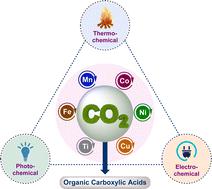当前位置:
X-MOL 学术
›
Chem. Soc. Rev.
›
论文详情
Our official English website, www.x-mol.net, welcomes your feedback! (Note: you will need to create a separate account there.)
Challenges and recent advancements in the transformation of CO2 into carboxylic acids: straightforward assembly with homogeneous 3d metals
Chemical Society Reviews ( IF 46.2 ) Pub Date : 2022-10-28 , DOI: 10.1039/d1cs00921d Robin Cauwenbergh 1 , Vishakha Goyal 2, 3 , Rakesh Maiti 1 , Kishore Natte 4 , Shoubhik Das 1
Chemical Society Reviews ( IF 46.2 ) Pub Date : 2022-10-28 , DOI: 10.1039/d1cs00921d Robin Cauwenbergh 1 , Vishakha Goyal 2, 3 , Rakesh Maiti 1 , Kishore Natte 4 , Shoubhik Das 1
Affiliation

|
The transformation of carbon dioxide (CO2) into useful chemicals, advanced materials, and energy is a long-standing challenge in both fundamental science and industry. In recent years, utilization of CO2 in the presence of inexpensive and non-negligible environmentally friendly 3d metal-based catalysts (Fe, Mn, Co, Ni, Cu and Ti) has become one of the most attractive topics. Particular attention has been given to the synthesis of carboxylic acids and their derivatives since these molecules serve as key intermediates in the chemical, fertilizer, and pharmaceutical sectors. Considering numerous challenges linked with CO2 reactivity, a number of research groups have recently focused on the transformation of CO2 into carboxylic acids by following thermo-, photo-, and electrochemical strategies. However, facile access to such acids remains a vital challenge in catalysis and in organic synthesis owing to the high stability of the CO2 molecule in which the carbon atom has the highest oxidation state. Another hurdle is to solve the selectivity issue caused by the reaction of different catalytic systems with CO2 in the presence of reactive functional group-containing molecules. Despite all these issues, a wide range of transition metal-based catalysts have been applied in this direction, but owing to their cheaper price and inherent reactivity, 3d metals are at the forefront in the CO2 utilization domain. Considering these, we aim to summarise recent advances (over the past five years) of 3d-metal complexes and their reactivity towards the activation of CO2 for the synthesis of carboxylic acids. Furthermore, we discuss current research trends, knowledge gaps, and invigorating perspectives on future advances.
中文翻译:

将 CO2 转化为羧酸的挑战和最新进展:与均质 3d 金属的直接组装
将二氧化碳 (CO 2 ) 转化为有用的化学品、先进材料和能源是基础科学和工业领域的一项长期挑战。近年来,在廉价且不可忽略的环境友好型 3d 金属基催化剂(Fe、Mn、Co、Ni、Cu 和 Ti)存在下利用 CO 2已成为最具吸引力的话题之一。人们特别关注羧酸及其衍生物的合成,因为这些分子是化学、肥料和制药领域的关键中间体。考虑到与 CO 2反应性相关的众多挑战,许多研究小组最近将重点放在 CO 2的转化上通过遵循热、光和电化学策略转化为羧酸。然而,由于其中碳原子具有最高氧化态的 CO 2分子的高稳定性,容易获得此类酸仍然是催化和有机合成中的重要挑战。另一个障碍是解决在含反应性官能团的分子存在下不同催化体系与CO 2反应引起的选择性问题。尽管存在所有这些问题,但基于过渡金属的催化剂已广泛应用于此方向,但由于其价格便宜和固有的反应性,3d 金属在 CO 2中处于最前沿利用域。考虑到这些,我们的目标是总结 3d 金属配合物的最新进展(过去五年)及其对 CO 2活化以合成羧酸的反应性。此外,我们还讨论了当前的研究趋势、知识差距以及对未来发展的振奋人心的观点。
更新日期:2022-10-28
中文翻译:

将 CO2 转化为羧酸的挑战和最新进展:与均质 3d 金属的直接组装
将二氧化碳 (CO 2 ) 转化为有用的化学品、先进材料和能源是基础科学和工业领域的一项长期挑战。近年来,在廉价且不可忽略的环境友好型 3d 金属基催化剂(Fe、Mn、Co、Ni、Cu 和 Ti)存在下利用 CO 2已成为最具吸引力的话题之一。人们特别关注羧酸及其衍生物的合成,因为这些分子是化学、肥料和制药领域的关键中间体。考虑到与 CO 2反应性相关的众多挑战,许多研究小组最近将重点放在 CO 2的转化上通过遵循热、光和电化学策略转化为羧酸。然而,由于其中碳原子具有最高氧化态的 CO 2分子的高稳定性,容易获得此类酸仍然是催化和有机合成中的重要挑战。另一个障碍是解决在含反应性官能团的分子存在下不同催化体系与CO 2反应引起的选择性问题。尽管存在所有这些问题,但基于过渡金属的催化剂已广泛应用于此方向,但由于其价格便宜和固有的反应性,3d 金属在 CO 2中处于最前沿利用域。考虑到这些,我们的目标是总结 3d 金属配合物的最新进展(过去五年)及其对 CO 2活化以合成羧酸的反应性。此外,我们还讨论了当前的研究趋势、知识差距以及对未来发展的振奋人心的观点。



























 京公网安备 11010802027423号
京公网安备 11010802027423号